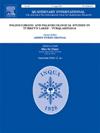Solar forcing as driver for late Holocene rainfall intensity in the Peruvian Andes
IF 1.9
3区 地球科学
Q3 GEOGRAPHY, PHYSICAL
引用次数: 0
Abstract
This study presents a high-resolution palaeoclimate record from sediment cores collected from the siltation area of Laguna Comercocha (LC) in southern Peru, spanning the last 1070 cal years. The primary objective was to investigate climatic variations and environmental changes before, during and after the Little Ice Age (LIA) in the central Andes, with particular emphasis on precipitation patterns and their relation to solar forcing. The extracted core provided a continuous sedimentary archive, offering insights into climate variability on sub-centennial to inter-decadal timescales. The methodology included analysing the sediment cores using X-ray fluorescence (XRF) to measure the concentrations of allogenic elements such as titanium (Ti), silicon (Si), potassium (K), iron (Fe) and calcium (Ca). Ti/coh ratios served as proxy for effective rainfall and runoff from the local catchment. In addition, pollen and non-pollen palynomorphs (NPPs) were identified and quantified to reconstruct past vegetation and climatic conditions. The study revealed that lithogenic input to the LC increased significantly after 1150 cal yr AD, likely due to increased precipitation. In particular, periods of increased lithogenic input were identified during the LIA, corresponding to solar minima and pointing to solar forcing as a major driver of precipitation changes in the central Andes.
太阳强迫是秘鲁安第斯山脉晚全新世降雨强度的驱动因素
本文介绍了从秘鲁南部Laguna Comercocha (LC)淤积区收集的沉积物岩心的高分辨率古气候记录,该记录跨越了过去1070 cal年。主要目的是调查安第斯山脉中部小冰期之前、期间和之后的气候变化和环境变化,特别强调降水模式及其与太阳强迫的关系。提取的岩心提供了一个连续的沉积档案,提供了对亚百年至年代际时间尺度的气候变化的见解。该方法包括使用x射线荧光(XRF)分析沉积物岩心,以测量钛(Ti)、硅(Si)、钾(K)、铁(Fe)和钙(Ca)等同种异体元素的浓度。Ti/coh比值代表了当地集水区的有效降雨量和径流量。此外,还对花粉和非花粉孢粉形态(NPPs)进行了鉴定和量化,以重建过去的植被和气候条件。研究表明,在公元1150 cal - yr之后,LC的岩性输入显著增加,可能是由于降水增加。特别地,在LIA期间确定了增加的岩性输入期,与太阳极小期相对应,并指出太阳强迫是安第斯山脉中部降水变化的主要驱动因素。
本文章由计算机程序翻译,如有差异,请以英文原文为准。
求助全文
约1分钟内获得全文
求助全文
来源期刊

Quaternary International
地学-地球科学综合
CiteScore
5.60
自引率
4.50%
发文量
336
审稿时长
3 months
期刊介绍:
Quaternary International is the official journal of the International Union for Quaternary Research. The objectives are to publish a high quality scientific journal under the auspices of the premier Quaternary association that reflects the interdisciplinary nature of INQUA and records recent advances in Quaternary science that appeal to a wide audience.
This series will encompass all the full spectrum of the physical and natural sciences that are commonly employed in solving Quaternary problems. The policy is to publish peer refereed collected research papers from symposia, workshops and meetings sponsored by INQUA. In addition, other organizations may request publication of their collected works pertaining to the Quaternary.
 求助内容:
求助内容: 应助结果提醒方式:
应助结果提醒方式:


